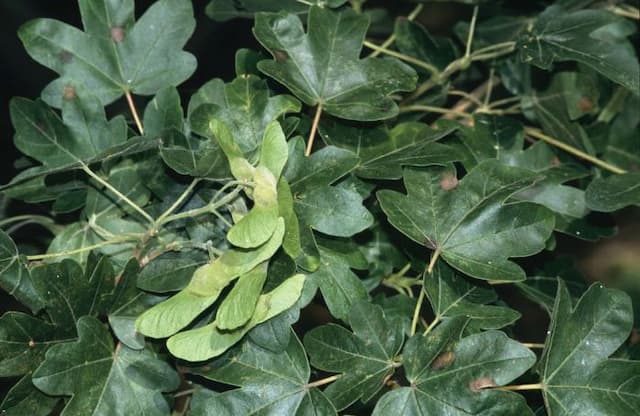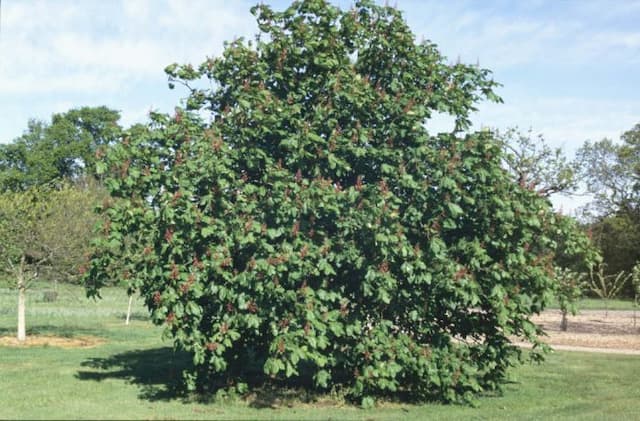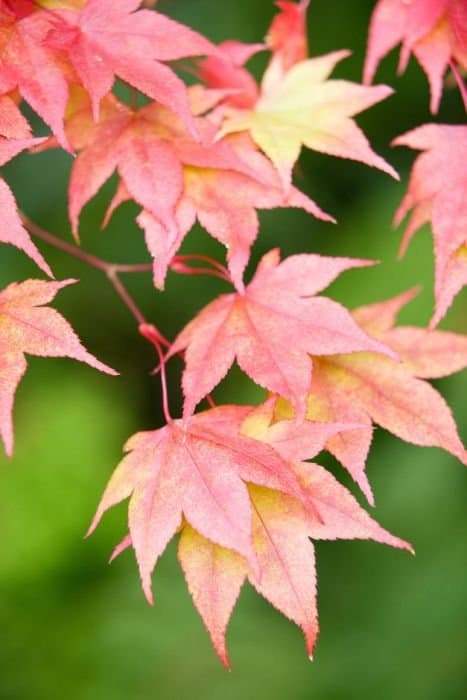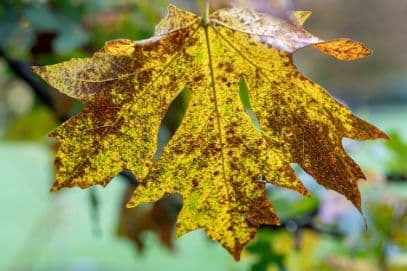Koelreuteria paniculata 'Rose Lantern'
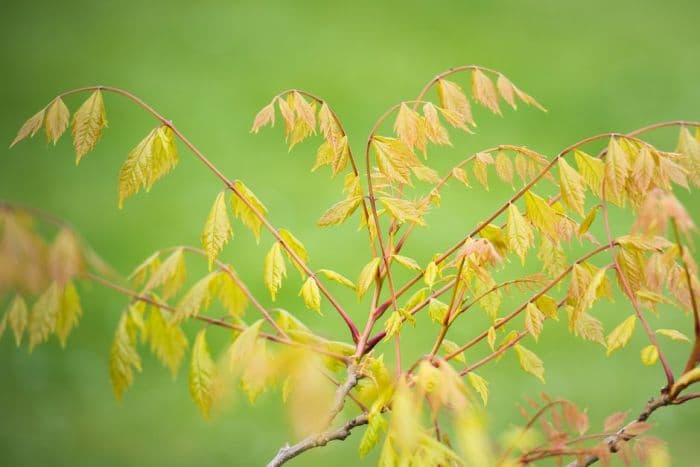
ABOUT
The Golden Rain Tree 'Rose Lantern' is a decorative tree that boasts a distinctive appearance across the seasons. It is adorned with compound leaves that are green in the warmer months and transition to bright shades of yellow, orange, or red as cooler weather arrives. In early summer, this tree becomes particularly eye-catching, featuring panicles of small, yellow flowers that bloom in abundance, resembling a shower of golden rain. As the blooms fade, the tree produces lantern-like seed pods that initially present a rose or pinkish color, hence the name 'Rose Lantern.' These papery lanterns provide a unique visual interest, starting out in their colorful tones before gradually aging to a beige or light brown as the season progresses. The tree has a rounded canopy that contributes to its ornamental charm, making it an attractive addition to landscapes where its year-round beauty can be thoroughly enjoyed.
About this plant
 Names
NamesFamily
Sapindaceae
Synonyms
Golden Rain Tree, Pride of India, Varnish Tree, China Tree
Common names
Koelreuteria apiculata, Koelreuteria bipinnata, Koelreuteria chinensis, Koelreuteria paniculata var. apiculata, Koelreuteria paniculata var. lixianensis, Koelreuteria paniculata var. pubescens, Koelreuteria paniculata var. subtrilobata, Sapindus chinensis, Sapindus paniculatus.
 Toxicity
ToxicityTo humans
The Golden Rain Tree is generally considered to be non-toxic to humans. However, it's always wise to exercise caution and avoid ingesting plants that are not known to be edible. If ingested, most people do not experience any adverse effects from the Golden Rain Tree, but individual sensitivities can vary. It is rare, but if a person were to experience symptoms after ingestion, they should seek medical attention.
To pets
The Golden Rain Tree is not commonly known to be toxic to pets. However, it is always best to prevent pets from eating ornamental plants as they could cause gastrointestinal upset or an unexpected allergic reaction in some animals. If your pet shows signs of illness after ingesting any part of this plant, such as vomiting, diarrhea, or unusual lethargy, contact your veterinarian.
 Characteristics
CharacteristicsLife cycle
Perennials
Foliage type
Deciduous
Color of leaves
Green
Flower color
Yellow
Height
20 feet (6 meters)
Spread
20 feet (6 meters)
Plant type
Tree
Hardiness zones
5
Native area
China
Benefits
 General Benefits
General Benefits- Ornamental Value: The Golden Rain Tree is known for its showy, yellow flowers that bloom in summer, adding a splash of color to the landscape.
- Shade Provider: This tree offers a canopy that provides shade, making outdoor spaces more comfortable during hot weather.
- Habitat for Wildlife: The tree's flowers attract pollinators, and its seeds provide food for birds and other wildlife.
- Drought Tolerance: Once established, the Golden Rain Tree is drought-tolerant, making it suitable for regions with water scarcity.
- Adaptability: It can adapt to a wide range of soil types and urban conditions, making it a versatile choice for city plantings.
- Seasonal Interest: With its changing colors through the seasons—from flowers to seed pods—the tree provides year-round visual interest.
- Fall Foliage: The Golden Rain Tree's leaves turn attractive shades of yellow in the fall before they drop, adding to its ornamental value.
 Medical Properties
Medical PropertiesThis plant is not used for medical purposes.
 Air-purifying Qualities
Air-purifying QualitiesThis plant is not specifically known for air purifying qualities.
 Other Uses
Other Uses- The Golden Rain Tree can be used in bonsai cultivation due to its attractive foliage and interesting branching patterns.
- Its dried seed pods can be incorporated into floral arrangements for a touch of natural beauty and unique texture.
- The sturdy wood of the Golden Rain Tree is sometimes used for woodworking projects, including small furniture items or decorative objects.
- The shade provided by the Golden Rain Tree makes it a good choice for creating comfortable outdoor seating areas in gardens and parks.
- Due to its tolerance for urban pollution, the tree serves as a street tree in cities, helping to green urban landscapes.
- Its bright yellow flowers can be pressed and used in crafts or as a natural dye for fabrics or paper.
- The tree's overall structure provides habitat for birds, including nesting sites and food from its seeds.
- In photography, the striking appearance of the Golden Rain Tree makes it a popular subject for landscape and nature photographers.
- The leaves, due to their shape and color, are sometimes used for seasonal decorations, particularly in the autumn.
- Golden Rain Tree can be planted in large containers for urban terraces or balconies, offering greenery in limited space environments.
Interesting Facts
 Feng Shui
Feng ShuiThe Golden Rain Tree is not used in Feng Shui practice.
 Zodiac Sign Compitability
Zodiac Sign CompitabilityThe Golden Rain Tree is not used in astrology practice.
 Plant Symbolism
Plant Symbolism- Abundance - Koelreuteria paniculata, commonly known as Golden Rain Tree, is often associated with abundance due to its prolific seed pods and vibrant blossoms that resemble showers of gold.
- Good Fortune - In some cultures, the Golden Rain Tree is considered a symbol of good luck, possibly due to its bright yellow flowers that may evoke the color of gold and wealth.
- Change - The Golden Rain Tree's seasonally changing appearance, from lush green to bright yellow flowers, and then to its distinctively colored seed pods, represents the ever-changing aspect of life.
- Resilience - This hardy tree is known for its ability to thrive in difficult conditions, symbolizing resilience and the ability to withstand challenges.
 Water
WaterThe Golden Rain Tree should be watered deeply once a week during its first growing season to help establish an extensive root system. After it is established, reduce frequency, except during extreme drought. Water the tree with about 10-15 gallons per week depending on rainfall and soil conditions. The goal is to mimic rainfall, allowing the water to seep deeply into the soil around the roots. Avoid frequent shallow waterings, as they encourage surface roots which can be easily damaged by heat or drought.
 Light
LightThe Golden Rain Tree thrives in full sun. The ideal spot for this plant is an area that receives at least 6 hours of direct sunlight each day. It can tolerate some light shade, but its flowering and fall color are best in full sun. Avoid heavily shaded areas to ensure proper growth and health.
 Temperature
TemperatureThe Golden Rain Tree is quite adaptable and can tolerate a wide range of temperatures. It can survive minimum temperatures between -20 to -10 degrees Fahrenheit but prefers a range from 50 to 90 degrees Fahrenheit for optimal growth. However, extreme heat above 100 degrees Fahrenheit can stress the tree.
 Pruning
PruningPrune the Golden Rain Tree to remove any dead or broken branches, to maintain shape, and to encourage new growth. It is best to prune in late winter or early spring before the tree begins to leaf out. Pruning while the tree is dormant will minimize stress on the tree. Occasional thinning of the canopy can help to allow light and air to filter through the branches.
 Cleaning
CleaningAs needed
 Soil
SoilGolden Rain Tree thrives in a well-draining loam soil rich in organic matter, with a pH ranging from 5.5 to 7.5. A mix consisting of garden soil, compost, and perlite or coarse sand can provide the necessary drainage and nutrients.
 Repotting
RepottingThe Golden Rain Tree does not typically require frequent repotting and can be repotted every 3 to 5 years or when it outgrows its current container.
 Humidity & Misting
Humidity & MistingGolden Rain Tree prefers moderate humidity levels but is quite adaptable and can tolerate the humidity levels typically found in most outdoor environments.
 Suitable locations
Suitable locationsIndoor
Keep in a sunny spot, protect from cold drafts.
Outdoor
Plant in full sun, water deeply, and mulch base.
Hardiness zone
5-9 USDA
 Life cycle
Life cycleKoelreuteria paniculata 'Rose Lantern', commonly known as the Golden Rain Tree, begins its life with seed germination that occurs naturally in spring when soils warm and moisture is adequate. The seedling stage follows, characterized by initial root establishment and leaf growth. As the tree enters the juvenile phase, rapid stem elongation takes place, and compound leaves with an unusual pink, bronze, or purplish hue emerge, later maturing to a bright green. Once mature, the tree annually produces panicles of yellow flowers in mid-summer, which are followed by distinctive, bladder-like, rose-colored seed pods. In autumn, the foliage turns to bright yellow before leaf drop. The Golden Rain Tree reaches the mature phase in several years and can live for 50 to 150 years, continuing to flower and produce seeds throughout its lifespan.
 Propogation
PropogationPropogation time
Spring to early summer
The most popular method of propagating the Golden Rain Tree, or Koelreuteria paniculata 'Rose Lantern', is through seed collection and sowing. Seeds should ideally be collected in the fall when the tree's distinctive lantern-like seed pods turn from green to a papery, rose-colored brown. After collection, seeds may require a period of cold stratification, which involves chilling the seeds for several weeks (a process that mimics natural winter conditions and can help break seed dormancy). This can usually be achieved by placing the seeds in moist sand or a mix of peat and perlite, then storing them in the refrigerator at about 40 degrees Fahrenheit (4.4 degrees Celsius). After stratification, seeds are sown in spring, typically just beneath the surface of a well-draining soil mix, and germinated under warm conditions. Seedlings tend to grow rapidly and can be transplanted outdoors once all danger of frost has passed and they are large enough to handle.
